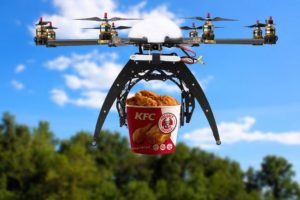Technology all tied up
2017 will be the year for Hospitality Operators to get their house in order from a technology solutions perspective. Many in the industry have spent the past few years testing and trialling everything from mobile ordering and payment, self-service kiosks, Bluetooth beacon marketing, digital menus and signage and much more and one of the key learnings that has come to the fore is the need to remove the complexity of underlying disparate databases and systems and for a unification of back-end systems for front-end gains.
So our predicted trends this year are not solely focused on innovation for innovation’s sake but a shift in emphasis on getting the underlying infrastructure in working order today to support the latest and greatest that technology has to offer tomorrow.
1. Technology that tackles labour costs.
Last year the significant increases in minimum wage had restaurant operators scrambling to reduce costs elsewhere in the business and identify ways self-service technology could help them with their growing labour bills. How much could staff costs really increase you ask? Well, Costa Coffee claimed 7,000 employees were entitled to an extra 50p per hour. This equates to an increase of £28,000 per day and a staggering £10,220,000 per year in staff costs!
With this not insignificant factor affecting operators’ financial planning, many turned to self-service to answer their wage woes. While operators were put off but the initial capital expenditure that kiosks and tablets incur, mobile kept things lean by letting customers use their own smartphones to order, pay and otherwise manage their entire experience themselves.
A move to mobile by ambitious operators will continue throughout this year and we predict that sub-hospitality sectors such as Travel Concessions, Coffee and Quick Service Restaurants will lead this mobile genesis. Mobile will continue to evolve as operators’ back end systems become more integrated. We will see a move from table stakes functionality such as order and pay to more sophisticated engagement between brands and their guests such as highly personalised experiences and marketing campaigns based on past behaviours and location and context-specific intel.
2. A phased approach to omni-channel.
How often have you heard that word ‘omni-channel’? Does it mean something to you as an operator or has it become a lame buzzword, thrown about by technology providers keen to impress? At QikServe, we predict a move by operators to offer a genuine omni-channel experience for their guests. So what does it actually entail?
With omni-channel, your guests can mix and match the ways they choose to interact with you as a brand and, importantly, maintain the context between each channel in real-time. So, as a consumer, I might want to browse your menu on my tablet at home, order on-the-move through my mobile and pay when I come to pick-up my food on-site and I don’t want to start a new session or login every time I engage with you, I want to you ‘know’ where I am in the overall journey. This type of omni-channel experience doesn’t happen overnight, and as we alluded to in the intro, this is the year operators implement solutions that grow with their business in a phased approach rather than offering an all singing, all dancing product that promises a lot but is, in reality, less than robust.
What does a phased approach look like? Some operators like the idea of mobile order and pay but feel their customers (especially the older generations) aren’t ready to make the move to mobile and feel kiosks and tablets are a good intermediate step. Even within a channel, a phased approach is sensible. Operators keen for their app to order and pay for food, open social channels, provide ancillary information about locations or merchandise, locate stores, open hotel room doors, offer an extensive loyalty scheme, choose in-store music and more, often over-functionalise their app to the detriment of the customer experience. The solution becomes clunky, disjointed and, although designed to be everything to anyone, ends up being effective for no one.
3. Simplifying back-end system complexities.
Highly relevant to the phased approach trend is a move away from the raft of technology providers offering speciality solutions but more of an integrated approach. For example, operators will stop choosing one company to create their mobile app and another company to develop their kiosks and another to integrate order and pay functionality on their websites. Instead, we predict master content management and integration platform providers will become the technology supplier of choice offering flexible, powerful functionality regardless of channel of deployment.
These platform providers will be able to offer a unified view of all your guest-facing integrations ensuring the power of payment, CRM, loyalty, and POS can be played out across all your guest-facing channels. No more manual importing of spreadsheets in and out of databases, no more translation issues from one back end system with another. With one platform that pulls in information from all these systems to inform guest facing engagement, operators can simplify their operations and transform their customer experience at the same time.
4. Mobile payments that matter.
Last year in the US, there was a liability shift for operators that hadn’t moved to EMV. These operators are now liable for any data breaches and chargebacks to the business which had them scrambling to upgrade or enhance their POS systems to accept EMV payments.
Now that that dust has settled, operators can take a more measured look at the payment options they offer their customers. We predict that this year, rather than forking out on expensive EMV payment terminals, operators will increasingly turn to mobile payments to overcome their EMV hurdles.
According to Forrester, US mobile payments is expected to reach $142B by 2019 and Oxygen 8 Group found coffee shops, cafes & sandwich bars and supermarkets are the top 3 locations mobile users want to use mobile payments. These numbers show US consumers are already familiar with using their smartphones to pay for things and continuing to encourage mobile payments throughout your restaurants, coffee shops and other types of hospitality venues, means reducing guests’ reliance on EMV and, importantly, a need for fewer EMV compliant terminals bringing costs down dramatically.
 5. The robots are coming! To deliver my pizza.
5. The robots are coming! To deliver my pizza.
So robots. Crazy gimmick or will they become reality? As alien as it seems to us today that our room service or takeaway pizza might be delivered by R2D2, we predict that it will become more of a reality. Perhaps not in 2017 but in a couple of years we could see more drone deliveries and robot waiters.
We’re already seeing the likes of Amazon and Google testing drone delivery as well as seeing critical medical equipment such as defibrillators being dispatched to emergency situations so why should the food industry not look to robots to execute similar functions? Last year Just Eat partnered with Starship Technologies to do just that. The robot courier is a 6-wheeled automated trolley that can travel at 4mph for roughly 10 miles and uses GPS and cameras to navigate and avoid obstacles.
 Again, relating to the staffing issues mentioned earlier, David Buttress, CEO of Just Eat commented, “In busy times, there’s a shortage of supply drivers. These [robots] will enable restaurants to meet the demand.”
Again, relating to the staffing issues mentioned earlier, David Buttress, CEO of Just Eat commented, “In busy times, there’s a shortage of supply drivers. These [robots] will enable restaurants to meet the demand.”
We might not see cohorts of Darlek deliveries this year but keep your eyes on the skies and your ears to the ground, you might bump into one of two when you’re out and about!





